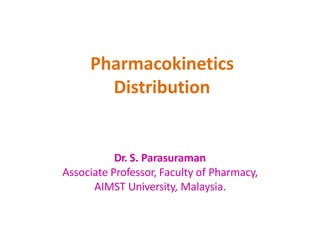
Distribution
- 1. Pharmacokinetics Distribution Dr. S. Parasuraman Associate Professor, Faculty of Pharmacy, AIMST University, Malaysia.
- 2. Academic session: Mar. - Jul. 2022 (FoP) 2 Pharmacokinetics - distribution • Drug distribution reversibly leaves is the process by which a drug the bloodstreamand enters the interstitium (extracellular fluid) and the tissues. • Movement of drug proceeds until an equilibrium is established between unbound drug in the plasma and the tissue fluids.
- 3. Pharmacokinetics - distribution • Apparent volume of distribution (V). • Presuming that the body behaves as a single homogeneous compartment with volume V into which the drug gets immediately and uniformly distributed. Academic session: Mar. - Jul. 2022 (FoP) 3
- 4. Academic session: Mar. - Jul. 2022 (FoP) 4 Pharmacokinetics - distribution • Apparent volume of distribution (V). Calculation: • A 58 kg male patient is given 350 milligrams of Drug B, which distributes throughout extracellular fluid, but not readily into tissues. On measuring a peak level, we may get a value of 20 milligrams per litter. Calculate the apparent volume of distribution per Kg body weight. = 350/20 = 17.5 litter of plasma = 17.5/58 = 0.30 litter/ kg
- 5. Academic session: Mar. - Jul. 2022 (FoP) 5 Pharmacokinetics - distribution • The distribution of a drug from the plasma to the interstitium depends on A. Cardiac output and local blood flow B. capillary permeability C. Binding of drugs to plasma proteins and tissues D. Lipophilicity E. Volume of distribution
- 6. Academic session: Mar. - Jul. 2022 (FoP) 6 Distribution of a drug depends on A. Cardiac output and local blood flow – The rate of blood flow to the tissue capillaries varies widely. – Blood flow to “vessel-rich organs” (brain, liver, and kidney) is greater than that to the skeletal muscles. – High blood flow, together with high lipophilicity permits rapid distribution
- 7. Academic session: Mar. - Jul. 2022 (FoP) 7 Distribution of a drug depends on B. Capillary permeability – Capillary permeability is determined by capillary structure and by the chemical nature of the drug. Capillary structure varies in terms of the fraction of the basement membrane exposed by slit junctions between endothelial cells. – In the liver and spleen, a significant portion of the basement discontinuous capillaries through which large membrane is exposed due to large, plasma proteins can pass. In the brain, the capillary structure is continuous, and there are no slit junctions. To enter the brain, drugs must pass through the endothelial cells of the CNS capillaries or undergo active transport.
- 8. Distribution of a drug depends on B. Capillary permeability Academic session: Mar. - Jul. 2022 (FoP) 8
- 9. Academic session: Mar. - Jul. 2022 (FoP) 9 Distribution of a drug depends on C. Binding of drugs to plasma proteins and tissues – Binding to plasma proteins: Reversible binding to plasma proteins sequesters drugs in a nondiffusible form and slows transfer out of the vascular compartment. Many drugs reversibly bind to albumin, 1-acid glycoprotein, or other proteins in plasma. Albumin is the major drug- binding protein, and it may act as a drug reservoir. Drug bound to albumin is not filtered by renal glomerulus but may be cleared by the proximal renal tubule and liver. – The extent of binding to proteins is dependent on several factors such as affinity, number of binding sites, and drug concentrations at the site.
- 10. Academic session: Mar. - Jul. 2022 (FoP) 10 Distribution of a drug depends on C. Binding of drugs to plasma proteins and tissues – Binding to tissue proteins: Many drugs accumulate in tissues, leading to higher concentrations in tissues than in interstitial fluid and blood. Drugs may accumulate because of binding to lipids, proteins, or nucleic acids. Drugs may also undergo active transport into tissues. Tissue reservoirs may serve as a major source of the drug and prolong its actions or cause local drug toxicity.
- 11. Academic session: Mar. - Jul. 2022 (FoP) 11 Distribution of a drug depends on D. Lipophilicity: – The chemical nature of a drug strongly influences its ability to cross cell membranes. Lipophilic drugs readily move across most biologic membranes. By contrast, hydrophilic drugs do not readily penetrate cell membranes and must pass through slit junctions.
- 12. Distribution of a drug depends on E. Volume of distribution – The apparent volume of distribution (Vd) is defined as the fluid volume that is required to contain the entire drug in the body at the same concentration measured in the plasma. It is calculated by dividing the dose that ultimately gets into the systemic circulation by the plasma concentration at time zero (C0). Academic session: Mar. - Jul. 2022 (FoP) 12
- 13. Academic session: Sep. 2018 - Jan. 2019 (BPT) 13 Distribution of a drug depends on E. Volume of distribution calculation: • 64-year-old female patient (70 kg) was recently diagnosed with gram-positive pathogenic infection. He received 2000 mg of vancomycin as an IV loading dose. The peak plasma concentration of vancomycin was reported to be 28.5 mg/L. The apparent volume of distribution is: = Amount of drug/ Plasma concentration = 2000/28.5 = 70.2 L for 70 kg = 1 L/ kg
- 14. Academic session: Sep. 2018 - Jan. 2019 (BPT) 14
